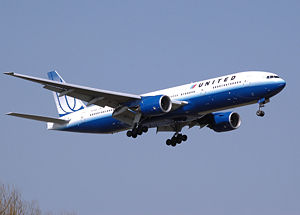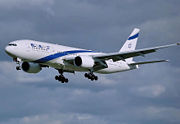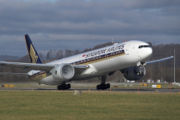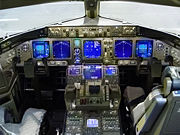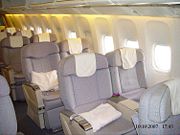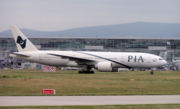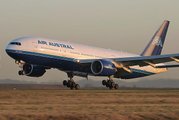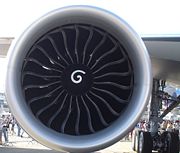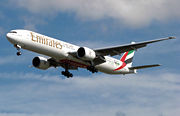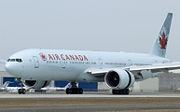Boeing 777
2008/9 Schools Wikipedia Selection. Related subjects: Air & Sea transport
| Boeing 777 | |
|---|---|
|
Boeing 777-200 of United Airlines, the launch customer of the 777 |
|
| Type | Airliner |
| Manufacturer | Boeing Commercial Airplanes |
| Maiden flight | June 12, 1994 |
| Introduction | June 7, 1995 with United Airlines |
| Primary users | Singapore Airlines Air France-KLM Emirates Airline United Airlines |
| Produced | 1993 - Present |
| Number built | 672 as of October 2007 |
| Unit cost | US$187.5-253 million |
The Boeing 777 is an American long-range, wide-body twin-engine airliner built by Boeing Commercial Airplanes. The world's largest twinjet and commonly referred to as the Triple Seven, it can carry between 301 and 368 passengers in a three-class configuration and has a range from 5,235 to 9,450 nautical miles (9,695 to 17,500 km). Distinguishing features of the 777 include the six wheels on each main landing gear, its circular fuselage cross section, the largest diameter turbofan engines of any aircraft, the pronounced "neck" aft of the cockpit, and the blade-like tail cone.
Singapore Airlines is the largest operator of the Boeing 777 family with 69 in service (46 are the 777-200ER variant, 12 are 777-300s, and 11 are 777-300ERs with 8 on firm order and 13 more on option). As of November 2007, 53 customers have placed orders totaling over 1,000 777s.
Direct market competitors to the 777 are the Airbus A330-300, A340, and some models of the currently under development A350 XWB. The 777 may eventually be replaced by a new product family, the Y3, which would draw upon technologies from the 787. The Y3 may also replace the 747 series.
Development
Background
In the 1970s, Boeing unveiled new models: the twin-engine 757 to replace the venerable 727, the twin-engine 767 to challenge the Airbus A300, and a trijet 777 concept to compete with the DC-10 and the Lockheed L-1011 TriStar. Based on a re-winged 767 design, the 275 seat 777 was to be offered in two variants: a 2,700 nautical miles (5,000 km) transcontinental and an 4,320 nmi (8,000 km) intercontinental.
The twinjets were a big success, due in part to the 1980s ETOPS regulations. However the trijet 777 was cancelled (much like the trijet concept of the Boeing 757) in part because of the complexities of a trijet design and the absence of a 40,000 lbf (178 kN) engine. The cancellation left Boeing with a huge size and range gap in its product line between the 767-300ER and the 747-400. The DC-10 and L-1011, which entered service in early 1970s, were also due for replacement. In the meantime, Airbus developed the A340 to fulfill that requirement and to compete with Boeing.
Design phase
In the mid-1980s Boeing produced proposals for an enlarged 767, dubbed 767X. There were also a number of in-house designations for proposals, of which the 763-246 was one internal designation that was mentioned in public. The 767X had a longer fuselage and larger wings than the existing 767, and seated about 340 passengers with a maximum range of 7,300 nautical miles (13,500 kilometers). The airlines were unimpressed with the 767X: they wanted short to intercontinental range capability, a bigger cabin cross section, a fully flexible cabin configuration and an operating cost lower than any 767 stretch. By 1988 Boeing realized that the only answer was a new design, the 777 twinjet.
Designing of the 777 was different from previous Boeing jetliners. For the first time, eight major airlines ( Cathay Pacific, American, Delta, ANA, BA, JAL, Qantas, and United) had a role in the development of the plane as part of a "Working Together" collaborative model employed for the 777 project.
At the first "Working Together" meeting in January 1990, a 23-page questionnaire was distributed to the airlines, asking each what it wanted in the new design. By March 1990 a basic design for the 767X had been decided upon; a cabin cross-section close to the 747s, 325 passengers, fly-by-wire controls, glass cockpit, flexible interior, and 10% better seat-mile costs than the A330 and MD-11. ETOPS was also a priority for United Airlines.
All software, whether produced internally to Boeing or externally, was to be written in Ada. The bulk of the work was undertaken by Honeywell who developed a Airplane Information Management System (AIMS). This handles the flight and navigation displays, systems monitoring and data acquisition (eg flight data acquisition).
United's replacement program for its aging DC-10s became a focus for Boeing's designs. The new aircraft needed to be capable for flying three different routes; Chicago to Hawaii, Chicago to Europe and non-stop from the hot and high Denver to Hawaii.
In October 1990, United Airlines became the launch customer when it placed an order for 34 Pratt & Whitney-powered 777s with options on a further 34. Production of the first aircraft began in January 1993 at Boeing's Everett plant near Seattle. In the same month, the 767X was officially renamed the 777, and a team of United 777 developers joined other airline teams and the Boeing team at the Boeing Everett Factory. Divided into 240 design teams of up to 40 members, working on individual components of the aircraft, almost 1,500 design issues were addressed.
The 777 was the first commercial aircraft to be designed entirely on computer. Everything was created on a 3D CAD software system known as CATIA, sourced from Dassault Systemes. This allowed a virtual 777 to be assembled, in simulation, to check for interferences and to verify proper fit of the many thousands of parts before costly physical prototypes were manufactured. Boeing was not totally convinced of the abilities of the program, and built a mock-up of the nose section to test the results. It was so successful that all further mock-ups were canceled.
Into production
The 777 included substantial international content, to be exceeded only by the 787. International contributors included Mitsubishi Heavy Industries and Kawasaki Heavy Industries (fuselage panels), Fuji Heavy Industries, Ltd. (centre wing section), Hawker De Havilland ( elevators), ASTA ( rudder) and Ilyushin (jointly designed overhead baggage compartment).
On April 9, 1994 the first 777, WA001, was rolled out in a series of fifteen ceremonies held during the day to accommodate the 100,000 invited guests. First flight took place on June 14, 1994, piloted by 777 Chief Test Pilot John E. Cashman, marking the start of an eleven month flight test program more extensive than that seen on any previous Boeing model.
On May 15, 1995 Boeing delivered the first 777, aircraft WA006, to United Airlines. The FAA awarded 180 minute ETOPS clearance ("ETOPS-180") for PW4074 engined 777-200s on May 30, 1995, making the 777 the first aircraft to carry an ETOPS-180 rating at its entry into service. The 777's first commercial flight took place on June 7, 1995 from London's Heathrow Airport to Washington Dulles Airport. The development, testing, and delivery of the 777 was the subject of the documentary series, "21st century Jet: The Building of the 777."
Due to rising fuel costs, airlines began looking at the Boeing 777 as a fuel-efficient alternative compared to other widebody jets. With modern engines, having extremely low failure rates (as seen in the ETOPS certification of most twinjets) and increased power output, four engines are no longer necessary except for very large aircraft such as the Airbus A380 or Boeing 747.
Singapore Airlines is the largest operator of the Boeing 777 family with 68 in service, of which 46 are of the 777-200ER variant, 12 are 777-300s and 10 are 777-300ERs. Another 9 777-300ERs are on firm order, with 13 more on option. Although Singapore Airlines is the largest customer, Emirates Airline is set to become the largest customer of the Boeing 777 when it will have 95 Boeing 777s in its fleet by 2010, in which 54 will be 777-300ERs. At the moment, Emirates Airline has 53 Boeing 777s in their fleet, of which 31 are Boeing 777-300ERs (with 23 on order), 12 Boeing 777-300s, 1 Boeing 777-200LR, 6 Boeing 777-200ERs, and 3 Boeing 777-200s.
Design
Boeing employed advanced technologies in the 777. These features included:
- Honeywell LCD glass cockpit flight displays
- Fully digital fly-by-wire flight controls with emergency manual reversion
- Fully software-configurable avionics
- Electronic flight bag
- Lighter design including use of composites (12% by weight)
- Fibre optic avionics network
- The largest and most powerful turbofan engines on a commercial airliner with a 128 inch (3.25 m) fan diameter on the GE90-115B1.
- The largest landing gear and the largest tires ever used in a commercial jetliner. Each main gear tire of a 777-300ER carries a maximum rated load of 64,583 lb (29,294 kg) when the aircraft is fully loaded, the heaviest load per tire of any production aircraft ever built.
Folding wingtips were offered when the 777 was launched but no airline has purchased this option. This feature was meant to appeal to airlines who might use the aircraft in gates made to accommodate smaller aircraft.
Boeing made use of work done on the cancelled Boeing 7J7, which had validated many of the chosen technologies. A notable design feature is Boeing's decision to retain conventional control yokes rather than fit sidestick controllers as used in many fly-by-wire fighter aircraft and in some Airbus transports. Boeing viewed stick and rudder controls as being more intuitive for pilots.
The 777 has the same Section 41 as the 767. This refers to the part of the aircraft from the tip of the nose, going to just behind the cockpit windows. From a head-on view, the end of the section is very evident. This is where the bulk of the aircraft's avionics are stored.
Some 777s also have crew rest areas in the crown area above the cabin. Separate crew rests can be included for the flight and cabin crew, with a two-person crew rest above the forward cabin between the first and second doors, and a larger overhead crew rest further aft with multiple bunks.
The interior of the Boeing 777, also known as the Boeing Signature Interior, has since been used on other aircraft, including the 767-400ER, 747-400ER, newer 767-200s and 767-300s. The interior on the Next Generation 737 and the Boeing 757-300 is loosely based on the 777's interior but also blends in aspects from the 757-200 interior. The 777 also features larger, more rounded, windows than most other aircraft. The 777-style windows were later adopted on the 767-400ER and Boeing 747-8. The Boeing 787 and Boeing 747-8 will feature a new interior evolved from the 777-style interior and, in the case of the 787, will have even larger windows.
Variants
Boeing uses two characteristics to define their 777 models. The first is the fuselage size, which affects the number of passengers and amount of cargo that can be carried. The 777-200 and derivatives are the base size. A few years later, the aircraft was stretched into the 777-300.
The second characteristic is range. Boeing defined these three segments:
- A market: 3,900 to 5,200 nautical miles (7,223 to 9,630 km)
- B market: 5,800 to 7,700 nautical miles (10,742 to 14,260 km)
- C market: 8,000 nautical miles (14,816 km) and greater
These markets are also used to compare the 777 to its competitor, the Airbus A340.
When referring to variants of the 777, Boeing and the airlines often collapse the model (777) and the capacity designator (200 or 300) into a smaller form, either 772 or 773. Subsequent to that they may or may not append the range identifier. So the base 777-200 may be referred to as a "772" or "772A", while a 777-300ER would be referred to as a "773ER", "773B" or "77W". Any of these notations may be found in aircraft manuals or airline timetables.
Initial models
777-200
The 777-200 (772A) was the initial A-market model. The first customer delivery was to United Airlines ( FAA: N777UA) in May 1995. It is available with a maximum take-off weight (MTOW) from 505,000 to 545,000 pounds (229 to 247 tonnes) and range capability between 3,780 and 5,235 nautical miles (7,000 to 9,695 km).
The -200 is currently powered by two 77,000 lbf (343 kN) Pratt & Whitney PW4077 turbofans, 77,000 lbf (343 kN) General Electric GE90-77Bs, or 76,000 lbf (338 kN) Rolls Royce Trent 877s.
The first 777-200 built was used by Boeing's non-destructive testing (NDT) campaign in 1994–1995, and provided valuable data for the -200ER and -300 programs (see below). This A market aircraft was sold to Cathay Pacific Airways and delivered in December 2000.
The direct equivalent from Airbus is the Airbus A330-300.
777-200ER
Originally known as the 777-200IGW (for "increased gross weight"), the longer-range B market 777-200ER (772B) features additional fuel capacity, with increased MTOW range from 580,000 to 631,000 pounds (263 to 286 tonnes) and range capability between 6,000 and 7,700 nautical miles (11,000 to 14,260 km). ER stands for Extended Range. The first 777-200ER was delivered to British Airways in February 1997, who also were the first carrier to launch, in 2001, a 10 abreast economy configuration in this airframe, which had originally been designed for a maximum 9 abreast configuration.
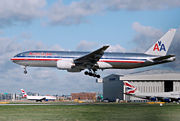
The 777-200ER can be powered by any two of a number of engines: the 84,000 lbf (374 kN) Pratt & Whitney PW4084 or Rolls-Royce Trent 884, the 85,000 lbf (378 kN) GE90-85B, the 90,000 lbf (400 kN) PW4090, GE90-90B1, or Trent 890, or the 92,000 lbf (409 kN) GE90-92B or Trent 892. In 1998 Air France took delivery of a 777-200ER powered by GE90-94B engines capable of 94,000 lbf (418 kN) thrust. The Rolls Royce Trent 800 is the leading engine for the 777 with a total market share of 43%. The engine is used on the majority of 777-200s, ERs and 300s but is not offered for the 200LR and 300ER.
On March, 1997, China Southern Airlines made history by flying the 1st Boeing 777 scheduled transpacific route, which was the flagship Guangzhou-Los Angeles route. On April 2, 1997, a Boeing 777-200ER, tail registration 9M-MRA (dubbed the "Super Ranger") of Malaysia Airlines, broke the Great Circle Distance Without Landing record for an airliner by flying east (the long way) from Boeing Field, Seattle, to Kuala Lumpur, Malaysia, a distance of 20,044 km (10,823 nmi), in 21 hours, 23 minutes, more than a scheduled range of B777-200LR The flight was non-revenue with no passengers on board. The plane is also recognized for another feat; the longest ETOPS-related emergency flight diversion (192 minutes under one engine power) was conducted on a United Airlines' Boeing 777-200ER carrying 255 passengers on March 17, 2003 over the southern Pacific Ocean—not without causing regulatory consternation.
The direct equivalents to the 777-200ER from Airbus are the Airbus A340-300 and the proposed A350-800.
As of August 2006, a total of 462 Boeing 777-200 aircraft were in airline service (with the 777-200ER total of 425 making it the most popular variant from the whole line), and a 53 further firm orders. Major operators include: Air China (10), Alitalia (10), All Nippon Airways (23, plus four on order), British Airways (45, plus 4 on order), El Al (8), Japan Airlines (25, plus one on order), Korean Air (11, plus seven on order), Malaysia Airlines (17), Saudi Arabian Airlines (23), Singapore Airlines (46), Vietnam Airlines (10), Air New Zealand (8), Air France (25), Alitalia (10), British Airways (43, plus 10 on order), KLM Royal Dutch Airlines (13, plus one on order), American Airlines (46, plus seven orders), Continental Airlines (20) and United Airlines (52). Some 19 other airlines also operate smaller numbers of the type.
777-300
The stretched A market 777-300 (773A) is designed as a replacement for 747-100s and -200s. Compared to the older 747s, the stretched 777 has comparable passenger capacity and range, but burns one third less fuel and has 40% lower maintenance costs.
It features a 33 ft 3 in (10.1 m) fuselage stretch over the baseline 777-200, allowing seating for up to 550 passengers in a single class high density configuration and is also 29,000 pounds (13 tonnes) heavier. The 777-300 has tailskid and ground maneuvering cameras mounted on the horizontal tail and underneath the forward fuselage to aid pilots during taxi due to the aircraft's length.
It was awarded type certification simultaneously from the U.S. FAA and European JAA and was granted 180 min ETOPS approval on May 4, 1998 and entered service with Cathay Pacific later in that month.
The typical operating range with 368 three-class passengers is 6,015 nautical miles (11,135 km). It is typically powered by two of the following engines: 90,000 lbf (400 kN) PW4090 turbofans, 92,000 lbf (409 kN) Trent 892 or General Electric GE90-92Bs, or 98,000 lbf (436 kN) PW-4098s.
Since the introduction of the -300ER in 2004, all operators have selected the ER version of the -300 model. This aircraft has no direct Airbus equivalent but the A340-600 is offered in competition.
As of August 2006, a total of 60 Boeing 777-300 aircraft are in airline service with All Nippon Airways (7), Cathay Pacific (12), Emirates Airline (12), Japan Airlines (7), Korean Air (4), Singapore Airlines (12) and Thai Airways International (6).
Longer range models
777-200LR
The 777-200LR (772C) ("LR" for "Longer Range") became the world's longest range commercial airliner when it entered service in 2006. Boeing named this plane the WorldLiner for its ability to connect almost any two airports in the world. It is capable of flying 9,450 nautical miles (17,501.40 km) in 18 hours. Developed alongside the 777-300ER, the 777-200LR achieves this with either 110,000 lbf (489 kN) thrust General Electric GE90-110B1 turbofans, or as an option, GE90-115B turbofans used on the -300ER. Rolls Royce originally offered the Trent 8104 engine with a thrust of 104,000 to 114,000 lbf (463 to 507 kN) that has been tested up to 117,000 lbf (520 kN). However, Boeing and Rolls Royce could not agree on risk-sharing on the project so the engine was eventually not offered to customers.
It features a significantly increased MTOW and three optional auxiliary fuel tanks manufactured by Marshall Aerospace in the rear cargo hold. Other new features include raked wingtips, a new main landing gear and additional structural strengthening. The roll-out was on February 15, 2005 and the first flight was at March 8, 2005. The second prototype made its first flight on May 24, 2005. The -200LR's entry into service was in January 2006. The only mass-produced aircraft with greater unrefueled range is the KC-10 Extender military tanker.
The 777-200LR was initially proposed as a 777-100X. It would have been a shortened version of the 777-200, analogous to the Boeing 747SP. The shorter fuselage would allow more of the take-off weight to be dedicated to fuel tankage, increasing the range. Because the aircraft would have carried fewer passengers than the 777-200 while having similar operating costs, it would have had a higher cost per seat. With the advent of more powerful engines the 777-100X proposal was replaced by the 777X program, which evolved into the Longer Range 777-200LR.
On November 10, 2005, a 777-200LR set a record for the longest non-stop flight by passenger airliner by flying 11,664 nautical miles (13,422 statute miles, or 21,602 km) eastwards (the westerly great circle route is only 5,209 nautical miles) from Hong Kong, China, to London, UK. The journey took 22 hours and 42 minutes. This was logged into the Guinness World Records and surpassed the average range of the Boeing 777-200LR at around 9,450 nmi.
On February 2, 2006, Boeing announced that the 777-200LR had been certified by both FAA and EASA to enter into passenger service with airlines.
The first Boeing 777-200LR was delivered to Pakistan International Airlines on February 26, 2006 and the second on March 23, 2006. There are at least eight Boeing 777s in service with PIA and the company plans to replace all of its older jets with the series. Under a deal, Pakistan also produces components and other spare parts for Boeing 777 series—last year Boeing bought components and spare parts from Pakistan worth $100 million.
Other customers include Air India and EVA Air. On November 9, 2005, Air Canada confirmed an order for the jets, which had previously been canceled due to labor issues. Emirates Airline announced on November 20, 2005 that they bought ten of these aircraft as part of a larger 777 order (42 in all). On September 12, 2006, Qatar Airways announced firm orders for the Boeing 777-200LR along with Boeing 777-300ER. On October 10, 2006, Delta Air Lines announced two firm orders of the aircraft to add to its long-haul routes and soon after announced three more orders.
Air New Zealand is also looking at the possibility of using the 777-200LR variant to add to their -200ERs for a new Auckland to New York route, beginning an ultra-long range route. They have four possible options.
The closest Airbus equivalent is the A340-500 (with 700 km less range than a Worldliner but free from ETOPS restrictions). A proposed future model, the A350-900R, aims to have a range up to 9,500 nautical miles or 17,600 km.
To compete with Airbus A350 for possible non-stop operation of the Kangaroo route (Sydney—London), Boeing proposed to lower the weight of the 777-200LR by using more composites. The weight reduction would be approximately 15,000 pounds (seven tonnes).
As of January 2008, 13 Boeing 777-200LR are in service, with 3 operated by Emirates Airline, 2 by Pakistan International Airlines, 4 by Air Canada, and 4 by Air India. Remaining orders total 42 from: Air India (4), Emirates Airline (7), EVA Air (2), Qatar Airways (6), Delta Air Lines (10), and Air Canada (6).
777-300ER
The 777-300ER is the Extended Range (ER) version of 777-300, and contains many modifications, including the GE90-115B engines, which are the world's most powerful jet engine with 115,300 lbf (513 kN) thrust. Other features include raked wingtips, a new main landing gear, extra fuel tanks (2,600 gallons), as well as strengthened fuselage, wings, empennage, nose gear, engine struts and nacelles, and a higher MTOW, 775,000 lb versus 660,000 lb for the 777-300. The maximum range is 7,930 nautical miles (14,685 km). The 777-300ER program was launched by Air France, though for political reasons, Japan Airlines was advertised as the launch customer. The first flight of the 777-300ER was February 24, 2003. Delivery of the first 777-300ER to Air France occurred on April 29, 2004.
The main reason for the 777-300ER's extra 1,935 nmi (3550 km) range over the 777-300 is not merely the capacity for an extra 2,600 gallons of fuel (45,220 to 47,890 gal), but the increase in the maximum take-off weight (MTOW).
The -300ER is slightly less fuel efficient than the regular -300 because it weighs slightly more and has engines that produce more thrust. Both the -300 and -300ER weigh approximately 360,000 lb empty and have the same passenger and payload capacity, but the ER has a higher MTOW and therefore can carry about 110,000 lb more fuel than the -300. This enables the -300ER to fly roughly 34% farther with the same passengers and cargo. Without the increase in fuel capacity due to larger fuel tanks, the -300ER's range would still be 25% greater at equal payload. In a maximum payload situation, the -300 would only be able to fill its fuel tanks about 60%, while the -300ER could be filled to full capacity.
Since the introduction of the -300ER, six years after the -300's first delivery, all orders for the -300 series have been the ER variant. The 777-300ER's direct Airbus equivalent is the A340-600HGW.
The 777-300ER has been test flown with only one working engine for as long as six hours and 29 minutes (389 minutes) over the Pacific Ocean as part of its Extended-range Twin-engine Operational Performance Standards (ETOPS) trials. 180 minutes of successful and reliable operation on one workable engine are required for the ETOPS 180-minute certification.
As of May 2007, a total of 76 Boeing 777-300ER aircraft are in airline service with Air Canada (5, plus 7 orders), All Nippon Airways (8, plus 5 orders), Arik Air (0, plus 3 orders), Emirates Airline (30, plus 36 orders), Etihad Airways (5 orders), EVA Air (7, plus 6 orders), Japan Airlines (6, plus 7 orders), Singapore Airlines (9, plus 10 orders), and Air France (17, plus 34 orders). Firm orders total 185 and include Emirates Airline (36 orders, 20 options), Air India (15 orders), Air New Zealand (4 orders, 3 options), Cathay Pacific (27 orders), Jet Airways (7,8 orders), Korean Air (10 orders), Pakistan International Airlines (3 orders), Philippine Airlines (4 orders, 2 leases), Qatar Airways (14 orders), KLM Royal Dutch Airlines (6 orders), TAM Linhas Aéreas (4 orders, 4 options), and V Australia (6 orders, 1 lease, 6 options).
777 Freighter
The 777 Freighter (777F) is an all-cargo version of the 777-200 which is expected to enter service in late 2008. It amalgamates features from the 777-200LR and the 777-300ER, using the -200LR's structural upgrades and 110,000 lbf (489 kN) GE90-110B1 engines, combined with the fuel tanks and undercarriage of the -300ER.
With a maximum payload of 103 tons, the 777F's capacity will be similar to the 112 tons of the 747-400F, with a nearly identical payload density. As Boeing's forthcoming 747-8 will offer greater payload than the -400F, Boeing is targeting the 777F as a replacement for older 747F and MD-11F freighters. It was launched on May 23, 2005.
The 777F promises improved operating economics compared to existing 100+ ton payload freighters. With the same fuel capacity as the 777-300ER, the 777F will have a range of 4,895 nmi (9,065 km) at maximum payload, although greater range will be possible if less weight is carried. For example, parcel and other carriers which are more concerned with volume than weight will be able to make non-stop trans-Pacific flights.
Airbus currently has no comparable aircraft but is developing two models with similar specifications to the 777F. The A330-200F will carry less payload but is a smaller and a cheaper alternative. With a capacity of around 90 tons the proposed A350-900F will be a more capable competitor, although slightly smaller than the 777F. The MD-11F is another comparable aircraft but with less range than the 777F. When the 777F enters service in 2008, it is expected to be the longest-range freighter in the world. The 747-400ERF can carry more cargo and travel farther than the 777F, but the 747-8F replacing it will have less range than the 747-400ERF in the interest of more payload.
On November 7, 2006, FedEx Express canceled its order of ten Airbus A380-800Fs, citing the delays in delivery. FedEx Express said it would buy 15 777Fs instead, with an option to purchase 15 additional 777Fs. FedEx's CEO stated that " the availability and delivery timing of this aircraft, coupled with its attractive payload range and economics, make this choice the best decision for FedEx."
Potential customers are EVA Cargo, LAN Cargo, Lufthansa Cargo and United Parcel Service. Air Canada and Air France-KLM have signed on as the 777F launch customers. The order for seven aircraft, (five for Air France and two for Air Canada) is worth US$1.5 billion at list prices, and the first delivery will be in 2008. Air Atlanta Icelandic has ordered eight 777F aircraft, while Emirates SkyCargo has also ordered eight. In December 2006, there were firm orders for a total of 49 777 Freighters from FedEx Express(15), Emirates SkyCargo (eight), Avion Group/Air Atlanta Icelandic (eight), China Southern Airlines (six), Air France (five), Guggenheim Aviation Partners (three, possibly four), Air Canada (two), and Qatar Airways (two). Air Canada has since converted their orders to the 777-300ER.
777 Tanker (KC-777)
The KC-777 is a proposed tanker version of the 777. In September 2006, Boeing publicly announced that it was ready and willing to produce the KC-777, if the USAF requires a bigger tanker than the KC-767. In addition the tanker will be able to transport cargo or personnel. Boeing instead offered its KC-767 Advanced Tanker for U.S. Air Force's KC-X competition in April 2007.
Specifications
| 777-200 | 777-200ER | 777-200LR | 777 Freighter | 777-300 | 777-300ER | |
|---|---|---|---|---|---|---|
| Cockpit crew | Two | |||||
| Seating capacity, typical |
305 (3-class) 400 (2-class) |
301 (3-class) 400 (2-class) |
301 (3-class) | N/A | 368 (3-class) 451 (2-class) |
365 (3-class) |
| Length | 209 ft 1 in (63.7 m) | 242 ft 4 in (73.9 m) | ||||
| Wingspan | 199 ft 11 in (60.9 m) | 212 ft 7 in (64.8 m) | 199 ft 11 in (60.9 m) |
212 ft 7 in (64.8 m) |
||
| Wing Sweepback | 31.64° | |||||
| Tail Height | 60 ft 9 in (18.5 m) | 61 ft 9 in (18.8 m) | 61 ft 1 in (18.6 m) | 60 ft 8 in (18.5 m) |
61 ft 5 in (18.7 m) |
|
| Cabin Width | 19 ft 3 in (5.86 m) | |||||
| Fuselage Width | 20 ft 4 in (6.19 m) | |||||
| Cargo Capacity | 5,655 ft³ (160 m³) 14 LD3 |
5,302 ft³ (150 m³) 6 LD3 |
22,455 ft³ (636 m³) 37 pallets |
7,080 ft³ (200 m³) 20 LD3 |
||
| Empty Weight | 307,000 lb (139,225 kg) |
315,000 lb (142,900 kg) |
326,000 lb (148,181 kg) |
353,600 lb (160,120 kg) |
366,940 lb (166,881 kg) |
|
| Maximum take-off weight | 545,000 lb (247,210 kg) |
656,000 lb (297,560 kg) |
766,000 lb (347,450 kg) |
660,000 lb (299,370 kg) |
775,000 lb (351,534 kg) |
|
| Cruising Speed | 0.84 Mach (560 mph, 905 km/h, 490 knots) at 35,000 ft cruise altitude | |||||
| Maximum Cruise Speed | 0.89 Mach (587 mph, 945 km/h, 510 knots) at 35,000 ft cruise altitude | |||||
| Maximum Payload Range | 3,250 NM (6,020 km) |
5,800 nm (10,740 km) |
7,500 nm (13,890 km) |
4,895 nm (9,065 km) |
3,800 nm (7,035 km) |
5,500 nm (10,190 km) |
| Maximum Range | 5,235 nm (9,695 km) |
7,700 nm (14,260 km) |
9,450 nm (17,500 km) |
4,895 nm (9,065 km) |
6,015 nm (11,135 km) |
7,930 nm (14,685 km) |
| Takeoff run at MTOW ISA+15 MSL | 8,200 ft (2,500 m) |
11,600 ft (3,536 m) |
11,200 ft (3,410 m) |
10,500 ft (3,200 m) |
||
| Maximum Fuel Capacity | 31,000 US gal (117,000 L) |
45,220 US gal (171,160 L) |
53,440 US gal (202,290 L) |
47,890 US gal (181,280 L) |
45,220 US gal (171,160 L) |
47,890 US gal (181,280 L) |
| Service Ceiling | 43,100 ft (13,140 m) | |||||
| Engine (x 2) | PW 4077 RR 877 GE90-77B |
PW 4090 RR 895 GE90-94B |
GE90-110B GE90-115B |
GE90-110B | PW 4098 RR 892 GE90-94B |
GE90-115B |
| Thrust (x 2) | PW: 77,000 lbf (330 kN) RR: 77,000 lbf (330 kN) GE: 77,000 lbf (330 kN) |
PW: 90,000 lbf (400 kN) RR: 95,000 lbf (420 kN) GE: 94,000 lbf (410 kN) |
GE: 110,000 lbf (480 kN) GE: 115,000 lbf (510 kN) |
GE: 110,000 lbf (480 kN) | PW: 98,000 lbf (430 kN) RR: 92,000 lbf (400 kN) GE: 94,000 lbf (410 kN) |
GE: 115,000 lbf (510 kN) |
Sources: Boeing 777 Specs, Boeing 777 Airport planning report Boeing 777 Airport planning report
777 sales
Orders
| 2007 | 2006 | 2005 | 2004 | 2003 | 2002 | 2001 | 2000 | 1999 | 1998 | 1997 | 1996 | 1995 | 1994 | 1993 | 1992 | 1991 | 1990 |
|---|---|---|---|---|---|---|---|---|---|---|---|---|---|---|---|---|---|
| 141 | 77 | 154 | 42 | 13 | 32 | 30 | 116 | 35 | 68 | 55 | 68 | 101 | 0 | 30 | 30 | 24 | 28 |
Deliveries
| 2007 | 2006 | 2005 | 2004 | 2003 | 2002 | 2001 | 2000 | 1999 | 1998 | 1997 | 1996 | 1995 | 1994 | 1993 | 1992 | 1991 | 1990 |
|---|---|---|---|---|---|---|---|---|---|---|---|---|---|---|---|---|---|
| 75 | 65 | 40 | 36 | 39 | 47 | 61 | 55 | 83 | 74 | 59 | 32 | 13 | 0 | 0 | 0 | 0 | 0 |
- Last Updated: Valid through December 2007
Incidents
- The only known fatality involving a Boeing 777 occurred in a refueling fire at Denver International Airport On September 5, 2001, during which a ground worker sustained fatal burns. Although the aircraft's wings were badly scorched, it was repaired and put back into service with British Airways.
- On October 18, 2002, An Air France Boeing 777-200 on route from Paris to Los Angeles made an emergency landing in Churchill, Manitoba when a small fire broke out by the front left windshield in the cockpit. Interestingly, passengers in rows 42-44 were the first to notice the odour and alert the flight crew. The aircraft dumped fuel over Hudson Bay before landing at Churchill. Because Churchill's airport does not regularly handle aircraft the size of a 777-200 the passengers deplaned using the slides.
- On August 24, 2004, A Singapore Airlines Boeing 777-312 had an engine explosion on takeoff at Melbourne Airport. This was due to erosion of the high pressure compression liners in the Rolls-Royce engines.
- On March 1, 2005, after a PIA Boeing 777-200ER landed at Manchester International Airport, England, fire was seen around the left main landing gear. The crew and passengers were evacuated and fire was put under control. Some passengers suffered minor injuries and the aircraft sustained minor damage.
- On August 1, 2005, Malaysia Airlines Flight 124, a 777-200ER had instruments showing conflicting reports of low airspeed on climb-out from Perth, Western Australia en route to Kuala Lumpur, Malaysia, then overspeed and stalling. The plane started to pitch up at 41,000 feet, and the pilots disconnected the autopilot and made an emergency landing at Perth. No one was injured. Subsequent examination revealed that one of the aircraft's several accelerometers had failed some years before, and another at the time of the incident.
- On January 17, 2008, British Airways Flight 38, a 777-200ER flying from Beijing to London, crash-landed approximately 1,000 feet (300 m) short of London Heathrow Airport's runway 27L, and slid onto the runway's threshold. This resulted in damage to the landing gear, wing roots and the engines. Despite a significant amount of fuel leak, there was no fire. An emergency evacuation followed with 1 serious and 12 minor injured persons. The initial report from the Air Accidents Investigation Branch stated that the Rolls-Royce Trent 895 engines repeatedly failed to respond to commands for more thrust from both the autothrottle system and from manual intervention, beginning when the aircraft was at an altitude of 600 feet (180 m) and 2 miles (3.2 km) from touchdown. The Seattle Times reports the aircraft "was damaged beyond repair". If confirmed this incident will be the first hull loss for the Boeing 777.
